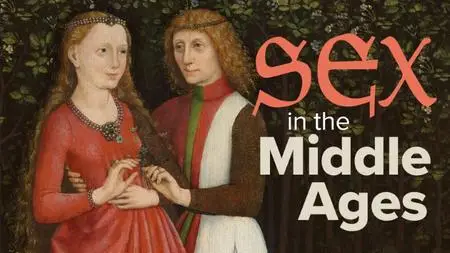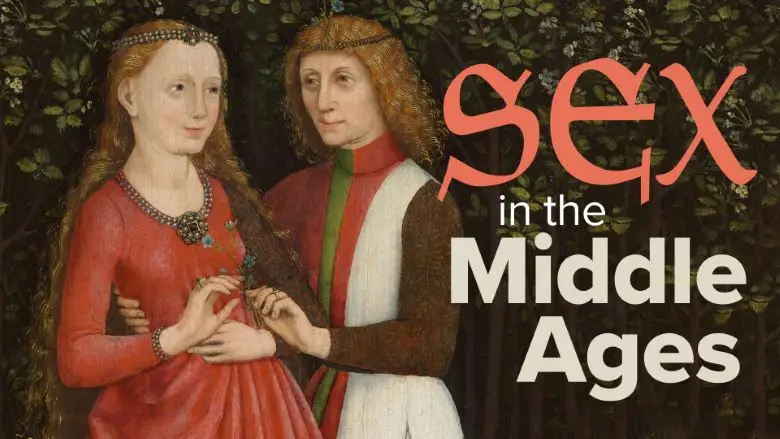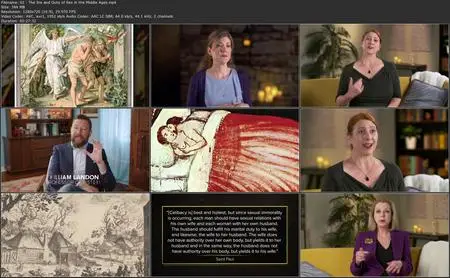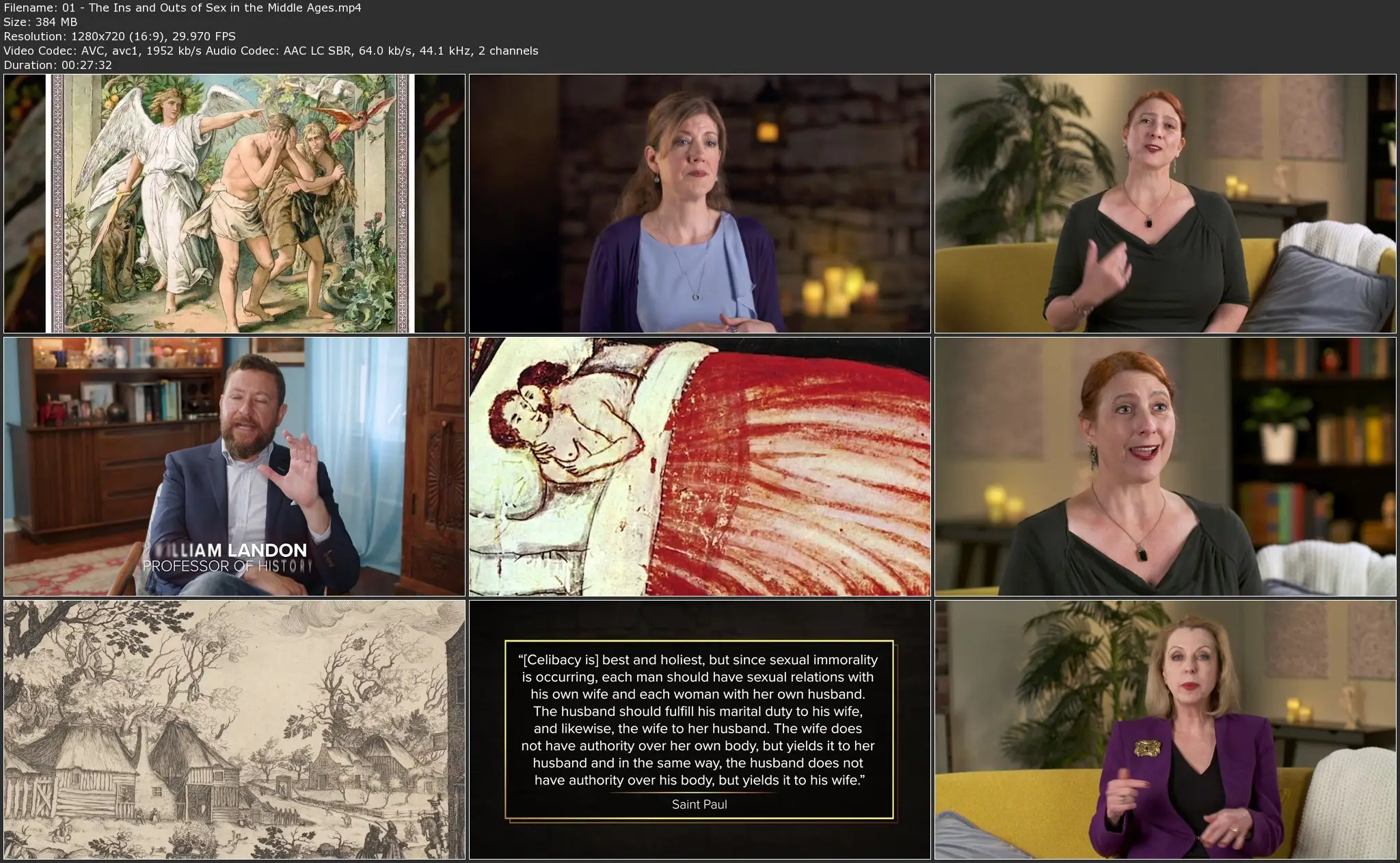TTC Video - Sex in the Middle Ages
.MP4, AVC, 1280x720, 30 fps | English, AAC, 2 Ch | 5h 14m | 4.35 GB
Lecturer: Jennifer McNabb, PhD Professor, University of Northern Iowa | Course No. 30660
.MP4, AVC, 1280x720, 30 fps | English, AAC, 2 Ch | 5h 14m | 4.35 GB
Lecturer: Jennifer McNabb, PhD Professor, University of Northern Iowa | Course No. 30660
Sex. The word makes some people giggle or blush, while others may draw back in discomfort. Whatever the reaction, whether positive or negative or a confusing mix of both, it’s rarely neutral. But sexual intercourse is a basic biological fact of life—and none of us would be here without it.
So, why do we find it so difficult to talk openly about sex? Where do the many rules and taboos surrounding sex and sexuality come from? How is it that a basic biological act can be so fraught with cultural, social, and moral complications?
In truth, much of our reticence in discussing and acknowledging the realities of sex comes, at least in part, from a unique time and place: medieval Europe. In the 12 episodes of Sex in the Middle Ages, Professor Jennifer McNabb and a panel of experts in medieval history and literature will take you back to the period between the fall of Rome and the rise of the Renaissance to explore the ideals and realities of sex and sexuality. As you’ll learn, the rise of Christianity as not just a religion but a powerful political institution irrevocably influenced both the practical and moral dimensions of sex for centuries. And you may be surprised to see how much medieval views of sex continue to influence us today.
From the crowned heads of Europe to the lowliest serf, sex and its consequences affected everyone. After all, for people in the Middle Ages, sex could determine the fate of a kingdom and the state of your immortal soul. With so much on the line, is there any doubt that sex occupied the medieval mind and became a focal point of politics, literature, art, and so much more? This deep-seated preoccupation means that looking at the past through sex and sexuality opens doors into so many other dimensions of medieval life and offers a fresh new perspective on history beyond the big events and famous names we are familiar with.
From the Bible to the Bedroom
When you think of the Middle Ages, what first comes to mind? Perhaps it’s the glorious cathedrals, the stunning art, or the courtly literature. Maybe you think of the political upheavals and religious transformations that so drastically shaped the era. For most of us, sex may be the last thing to come to mind when considering this period, and yet sex offers a spectacular lens through which to understand the ways medieval people thought and how they lived.
At its most basic, biological level, sex is the act necessary for procreation. There are myriad other reasons people engage in sex, but sex as the means to create life was a very popular topic of discussion in the Middle Ages. The medieval Church used the doctrine of Original Sin to transform a biological imperative into a moral one, proclaiming and enforcing the idea that sex is only permissible within marriage and to produce children.
With this in mind, Professor McNabb and her fellow experts begin their exploration of medieval notions of sex with a look at the Biblical narrative that set these rules in motion: the story of Adam and Eve. From this theological starting point, you’ll see how sex and religion became so thoroughly intertwined throughout the Middle Ages, and beyond. But you’ll also approach this perspective on history from a more practical vantage point as well, with a look at:
Since procreation was at the heart of medieval rules about sex, in the eyes of the Church, there was only one right way to have sex. That means there were a lot of “wrong” ways to indulge in sexual pleasure. With so many prohibitions and taboos, you’ll find that many people were often breaking the rules; and yet, as you’ll also discover, the severity of the punishments could vary greatly depending on who was breaking the rules and who was enforcing them.
Sex in Life and Literature
The Church’s official positions on sex and sexuality may have been clear, but that doesn’t mean there wasn’t confusion and debate, even within the ranks of the clergy itself. Many scholars and theologians wrote about sex and sexuality, discussing the finer points of how consent, relationships, and sex “should” work, leaving us a rich trove of information regarding the everyday reality of medieval sexuality. And since the Church was the foremost authority on sex from a spiritual perspective, it also became the source of advice for those who struggled with various sexual and marital issues in ordinary life.
As Professor McNabb and our panel of experts reveal, many clergy and clerical lawyers became the medieval version of “sexperts,” offering advice and guidance—although many of them took vows of lifetime celibacy. As the clergy were literate while most of the population was not, much of our information about medieval sex comes from the people who weren’t supposed to be having it.
Documents from the clergy and church officials are certainly not the only sources that can illuminate the sexual customs and beliefs of the Middle Ages. The erotic and courtly literature of the time may not give us facts, but as your experts highlight, these works can give fascinating insights into the anxieties, desires, and questions that captivated medieval audiences. While medieval literature is known for its courtly tales of chivalry and romance, a much more risqué form of storytelling existed that defied the rigid and repressed image many of us have of the Middle Ages.
A New View of the Middle Ages
While it may seem that the rules for sex and marriage were clear throughout the centuries during the Middle Ages, the truth is that the rules were regularly challenged and debated. The complexity of human relationships and the evolution of Christian thinking, theology, and law meant that marriage was never fixed and unchanging. As in all times throughout history, a considerable gap existed between ideals and reality. It is in these gaps that we often find the most fascinating and illuminating parts of the past.
While sexual relationships—like all relationships—have likely been complicated since the earliest days of human culture, many of our long-held ideas about the moral and social dimensions of sex can be traced back to the Middle Ages. The medieval drive to govern and regulate human sexuality, sexual identity, and sexual behavior—even as constant pushback against the rules—has cast a long cultural shadow.
As Sex in the Middle Ages so thoroughly illuminates, although medieval people lived markedly different lives than we do, we share the common bonds of humanity, including sex and the societal complications that come with it.
From the crowned heads of Europe to the lowliest serf, sex and its consequences affected everyone. After all, for people in the Middle Ages, sex could determine the fate of a kingdom and the state of your immortal soul. With so much on the line, is there any doubt that sex occupied the medieval mind and became a focal point of politics, literature, art, and so much more? This deep-seated preoccupation means that looking at the past through sex and sexuality opens doors into so many other dimensions of medieval life and offers a fresh new perspective on history beyond the big events and famous names we are familiar with.
From the Bible to the Bedroom
When you think of the Middle Ages, what first comes to mind? Perhaps it’s the glorious cathedrals, the stunning art, or the courtly literature. Maybe you think of the political upheavals and religious transformations that so drastically shaped the era. For most of us, sex may be the last thing to come to mind when considering this period, and yet sex offers a spectacular lens through which to understand the ways medieval people thought and how they lived.
At its most basic, biological level, sex is the act necessary for procreation. There are myriad other reasons people engage in sex, but sex as the means to create life was a very popular topic of discussion in the Middle Ages. The medieval Church used the doctrine of Original Sin to transform a biological imperative into a moral one, proclaiming and enforcing the idea that sex is only permissible within marriage and to produce children.
With this in mind, Professor McNabb and her fellow experts begin their exploration of medieval notions of sex with a look at the Biblical narrative that set these rules in motion: the story of Adam and Eve. From this theological starting point, you’ll see how sex and religion became so thoroughly intertwined throughout the Middle Ages, and beyond. But you’ll also approach this perspective on history from a more practical vantage point as well, with a look at:
- Medical theories—some often quite inaccurate—involving sex, fertility, and desire;
- Legal issues of sex and marriage in medieval society;
- Harsh realities of single motherhood, sexual violence, and sex work;
- Effects of class and gender on sexual behavior and expectations;
- Politics of sex;
- Ramifications of breaking sexual taboos; and more.
Since procreation was at the heart of medieval rules about sex, in the eyes of the Church, there was only one right way to have sex. That means there were a lot of “wrong” ways to indulge in sexual pleasure. With so many prohibitions and taboos, you’ll find that many people were often breaking the rules; and yet, as you’ll also discover, the severity of the punishments could vary greatly depending on who was breaking the rules and who was enforcing them.
Sex in Life and Literature
The Church’s official positions on sex and sexuality may have been clear, but that doesn’t mean there wasn’t confusion and debate, even within the ranks of the clergy itself. Many scholars and theologians wrote about sex and sexuality, discussing the finer points of how consent, relationships, and sex “should” work, leaving us a rich trove of information regarding the everyday reality of medieval sexuality. And since the Church was the foremost authority on sex from a spiritual perspective, it also became the source of advice for those who struggled with various sexual and marital issues in ordinary life.
As Professor McNabb and our panel of experts reveal, many clergy and clerical lawyers became the medieval version of “sexperts,” offering advice and guidance—although many of them took vows of lifetime celibacy. As the clergy were literate while most of the population was not, much of our information about medieval sex comes from the people who weren’t supposed to be having it.
Documents from the clergy and church officials are certainly not the only sources that can illuminate the sexual customs and beliefs of the Middle Ages. The erotic and courtly literature of the time may not give us facts, but as your experts highlight, these works can give fascinating insights into the anxieties, desires, and questions that captivated medieval audiences. While medieval literature is known for its courtly tales of chivalry and romance, a much more risqué form of storytelling existed that defied the rigid and repressed image many of us have of the Middle Ages.
A New View of the Middle Ages
While it may seem that the rules for sex and marriage were clear throughout the centuries during the Middle Ages, the truth is that the rules were regularly challenged and debated. The complexity of human relationships and the evolution of Christian thinking, theology, and law meant that marriage was never fixed and unchanging. As in all times throughout history, a considerable gap existed between ideals and reality. It is in these gaps that we often find the most fascinating and illuminating parts of the past.
While sexual relationships—like all relationships—have likely been complicated since the earliest days of human culture, many of our long-held ideas about the moral and social dimensions of sex can be traced back to the Middle Ages. The medieval drive to govern and regulate human sexuality, sexual identity, and sexual behavior—even as constant pushback against the rules—has cast a long cultural shadow.
As Sex in the Middle Ages so thoroughly illuminates, although medieval people lived markedly different lives than we do, we share the common bonds of humanity, including sex and the societal complications that come with it.





